

15 Wrong Ways to Implement the Common Core. Guest post by Johnna Weller, Ed D.
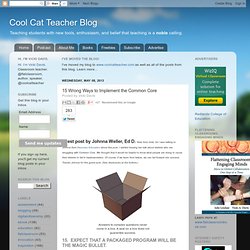
Note from Vicki: As I was talking to Johnna from Discovery Education about this post, I started hearing her talk about districts who are struggling with Common Core. We thought that it would be helpful to know what people are doing to cause their districts to fail in implementation. Of course, if we learn from failure, we can fail forward into success. Thanks Johnna for this guest post. (See disclosures at the bottom.) 15. We’ve all seen the labels on the cover of teacher’s manuals that say (in bold print), “Aligned to CCSS.” Of course, materials can be a helpful resource to teachers, but they are only as good as the teacher who uses them. “Programs don’t teach kids, teachers teach kids.” Response: Ways To Develop Creative Thinking In The Common Core - Classroom Q&A With Larry Ferlazzo.
Mary Jo Groeneveld asked: What are some tools teachers can use to address new common core standards while developing creative thinking?

Teachers are in a constant vice grip of time with too much curriculum to cover with unrealistic differentiation expectations for ever increasing numbers of students. They have a hard time justifying the time needed to move away from focused cognition. Do you have a collection of quick techniques, "tools" that teachers can insert easily, thus successfully into their structured, fast paced test and retest and report data regimen?
Today, three author educators -- Amy Benjamin, Ben Curran, and Heather Wolpert-Gawron -- have contributed guest responses to Mary Jo's question. Readers might also find these resources helpful: Response: Best Ways to Prepare Our Students for CCSS in Language Arts. Inspiring Creativity Through Nonfiction Texts. Wondering how to put Common Core into practice? It’s easier than you think. By Marc Aronson and Susan M.
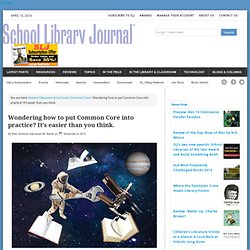
Bartle on November 8, 2012 Illustration by Amy Wasserman. This fall, as we’ve traveled around New York State doing workshops for librarians and teachers on the Common Core State Standards, we’ve been living and breathing the new education standards. Common Core’s English Language Arts (ELA) guidelines have become as familiar to us as our morning coffee. We assume that’s true for many of you, too. At the moment, 46 states (plus Texas, which has adopted similar guidelines under another name) are starting to put Common Core’s ELA guidelines into practice, and that’s great news for school librarians, especially since your skills, knowledge, and collections are essential to its success. As you’ve probably heard, Common Core’s ELA standards, which aim to prepare students to succeed in college and in their careers, have changed the way that reading is taught in K–12 schools.
You, the school librarian. The art of clustering What about older kids? Text trends. In Common Core, Teachers See Interdisciplinary Opportunities. Closer Readings. Mary Downs and Leah Weinryb Grohsgal, NEH Program Officers, Division of Preservation and Access Last week’s blog post introduced Chronicling America, a deep repository of historic American newspapers covering the years 1836–1922.

Students can use newspapers available through Chronicling America to expose the rich texture of the women’s rights movement and its many milestones, meetings, and debates right from the beginning and in a way that few other resources can. As an added bonus, they will be working with the kind of complex informational texts that the Common Core English Language Standards recommends. In what follows, we'll be suggesting articles written from a variety of points of view that make arguments based on appeals to evidence. Seneca Falls Convention Let’s begin with the coverage of early women’s rights advocates, including Lucretia Mott and Elizabeth Cady Stanton, who planned a two-day convention in Seneca Falls, New York, to discuss women’s role in society in July 1848.
{12 Days: Tool 3} Common Core Cheat Sheet. Tool 3: Cheat Sheet for the Common Core ELA & Literacy Standards The Common Core standards (CCSS) are getting a lot of attention these days. In preparation for implementing the standards, educators are attending workshops, webinars, reading, mapping, and discussing what implementation will look like and the challenges that go with it. Common Core: Resources To support educators in moving toward the Common Core, Learning Unlimited developed a Common Core page on our website which includes several resources and tools including the popular Common Core Toolkit .
Additionally, I recently offered 2 free webinars devoted to the Common Core ELA & Literacy standards. The Gettysburg Address: Literary Nonfiction and the Common Core. Although House of Cards on Netflix, the fictional Elmer Gantry and the preposterous Watergate cover-up all provide ammunition to those who view rhetoric pejoratively, rhetoric should be studied as a powerful tool for good.
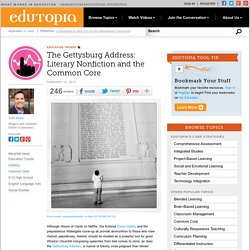
Winston Churchill composing speeches from bed comes to mind, as does the Gettysburg Address, a marvel of brevity more poignant than Winter Aconite, a speech that redefined the Civil War as a national fight for equality. The Gettysburg Address, composed by that hipster Abraham Lincoln, has never been more relevant, especially to the framers of the Common Core Curriculum Standards who appropriated Lincoln's address because of its literary rhetorical characteristics.
5 Methods for Developing Problem-Solving Skills. Non fiction- finding info and understanding how it is presented. McClennen's Close Reading Guide. Dr.
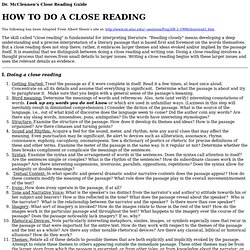
McClennen's Close Reading Guide The following has been Adapted From Albert Sheen's site at: The skill called "close reading" is fundamental for interpreting literature. "Reading closely" means developing a deep understanding and a precise interpretation of a literary passage that is based first and foremost on the words themselves. But a close reading does not stop there; rather, it embraces larger themes and ideas evoked and/or implied by the passage itself. I. Getting Started: Treat the passage as if it were complete in itself. Note that this process moves from the smallest bits of information (words, sound, punctuation) to larger groupings (images, metaphors) to larger concepts (themes). II. The paper should begin with a closely argued thesis, which is the result of the last step above. Helpful Links: Key elements to close readings: Jack Lynch’s keys to close reading: Common-Core-Standards-Overview-LU-revised. CCSS-Cheat-Sheet-Learning-Unlimited-by-Kimberly-Tyson.
The-Common-Core-Professional-Resources-K-Tyson-Learning-Unlimited1. Common Core Big Idea 5: Consider Meaningful Assessment. Editor's note: This is the fifth post in a five-part series which takes a look at five big ideas for implementation of the Common Core State Standards, authored by Jay McTighe and Grant Wiggins.
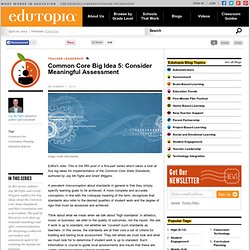
A prevalent misconception about standards in general is that they simply specify learning goals to be achieved. A more complete and accurate conception, in line with the colloquial meaning of the term, recognizes that standards also refer to the desired qualities of student work and the degree of rigor that must be assessed and achieved. Think about what we mean when we talk about “high standards” in athletics, music or business: we refer to the quality of outcomes, not the inputs. We ask if work is up to standard, not whether we “covered” such standards as teachers. Common Core Big Idea 4: Map Backward From Intended Results. Editor's note: This is the fourth post in a five-part series which takes a look at five big ideas for implementation of the Common Core State Standards, authored by Jay McTighe and Grant Wiggins The key to avoiding an overly discrete and fragmented curriculum is to design backward from complex performances that require content.

A return to the linguistic roots of “curriculum” reveals the wisdom in this outcome-focused view. The Latin meaning of the term is a “course to be run.” This original connotation helpfully suggests that we should think of a curriculum as the pathway toward a destination. As mentioned above, our conception is that curriculum should be framed and developed in terms of worthy outputs; i.e., desired performances by the learner, not simply as a listing of content inputs.
Common Core Big Idea 3: Standards Must Be Unpacked. Editor's note: This is the third post in a five-part series which takes a look at five big ideas for implementation of the Common Core State Standards, authored by Jay McTighe and Grant Wiggins As suggested in my previous post, the first step in translating the Common Core Standards into engaging and outcome-focused curriculum involves a careful reading of the documents in order to ensure clarity about the end results and an understanding of how the pieces fit together.
This idea is not new. Over the years, we have suggested various ways of unpacking standards in conjunction with our work with the Understanding by Design framework. Common Core Big Idea Series 2: The Standards Are Not Curriculum. Editor's note: This is the second post in a five-part series which takes a look at five big ideas for implementation of the Common Core State Standards, authored by Jay McTighe and Grant Wiggins The Introduction to the Common Core State Standards (CCSS) for Mathematics makes a noteworthy point: “These Standards do not dictate curriculum or teaching methods.”

(p 5). A similar point is offered by the ELA Standards: “The Standards define what all students are expected to know and be able to do, not how teachers should teach. For instance, the use of play with young children is not specified by the Standards, but it is welcome as a valuable activity in its own right and as a way to help students meet the expectations in this document… The Standards must therefore be complemented by a well-developed, content-rich curriculum consistent with the expectations laid out in this document.” So then, what is a curriculum? See more see less. Common Core Big Idea Series 1: A New Blueprint. Editor's note: This is the first post in a five-part series which takes a look at five big ideas for implementation of the Common Core State Standards, authored by Jay McTighe and Grant Wiggins In our travels around the country since the Common Core Standards were released, we sometimes hear comments such as, “Oh, here we go again;” “Same old wine in a new bottle;” or “We already do all of this.”

Such reactions are not surprising given the fact that we have been here before. A focus on standards is not new. However, it a misconception to assume that these standards merely require minor tweaks to our curriculum and instructional practices. In fact, the authors of the Mathematics Standards anticipated this reaction and caution against it: “These Standards are not intended to be new names for old ways of doing business.” 50 Common Core Resources For Teachers. Social Studies and the Common Core. In the perfect world in which my brain sometimes lives, my friends and I start our own private school. We design and run it the way schools are supposed to run. Problem-based / constructivist learning, integrated technology, the elimination of seat-based credit, tons of resources, and appropriate / effective assessments. Teacher Resources.
The Library of Congress offers classroom materials and professional development to help teachers effectively use primary sources from the Library's vast digital collections in their teaching. Find Library of Congress lesson plans and more that meet Common Core standards, state content standards, and the standards of national organizations. Discover and discuss ways to bring the power of Library of Congress primary sources into the classroom. Go to the blog Subscribe to the blog via e-mail or RSS. Using Primary Sources Discover quick and easy ways to begin using primary sources in your classroom, with teachers' guides, information on citing sources and copyright, and the Library's primary source analysis tool. TPS Partners The Teaching with Primary Sources Program builds partnerships with educational organizations to support effective instruction using primary sources.
The Teaching with Primary Sources Journal. Consortia Provide Preview of Common Assessments. Published Online: August 14, 2012. Teaching Channel: Videos, Lesson Plans and Other Resources for Teachers. Common Core State Standards and Library of Congress Teacher Resources: Find Lesson Plans (and More) That Meet Your CCSS Needs. The Common Core State Standards (CCSS) are on many teachers’ minds this school year, and the Library of Congress is ready to help. The Library’s teacher resources are a great fit for teachers trying to meet key CCSS goals, including critical thinking, analyzing informational texts, and working with primary sources. They’re all free, and finding them is as easy as going to www.loc.gov/teachers. The Search by Standards Tool on www.loc.gov/teachers.